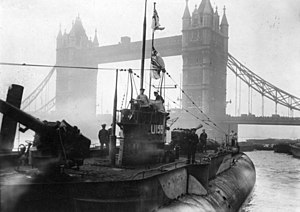Type U 151 U-boats were a class of large, long-range submarines initially constructed during World War I to be merchant submarines and later used by the Kaiserliche Marine (Imperial German Navy).
 U-155, a Type U 151 U-boat exhibited in London after the First World War.
| |
| Class overview | |
|---|---|
| Builders |
|
| Operators | |
| Completed | 7 |
| General characteristics [1] | |
| Displacement | |
| Length |
|
| Beam |
|
| Height | 9.25 m (30 ft 4 in) |
| Draught | 5.30 m (17 ft 5 in) |
| Installed power |
|
| Propulsion |
|
| Speed |
|
| Range |
|
| Test depth | 50 metres (160 ft) |
| Complement | 6 officers, 50 enlisted |
| Armament |
|
Background
editIn addition to the cargo-carrying submarines Deutschland and Bremen (disappeared on a cargo voyage in 1916 while it was still a merchant submarine), six further large cargo submarines were ordered, originally designed to ship material to and from locations otherwise denied German surface ships, such as the United States.[citation needed]
On 16 December 1916, four under construction in the Reiherstieg and Flensburger Schiffbau yards were taken over by the navy and converted to military specification as Type U 151 U-boats, being designated U-151 to U-154. The remaining two, along with Deutschland, which became U-155, passed into naval control in February 1917, as U-156 and U-157.[2]
All were fitted with two bow torpedo tubes and could carry 18 torpedoes, with the exception of the former Deutschland, which was fitted with six tubes. All were armed with two 15 cm (5.9 in) SK L/45 deck guns, and carried a crew of 56. They had a cruising range of around 25,000 nautical miles (46,000 km; 29,000 mi).
The success of the Type U 151 submarines led to "Project 46", the larger Type U 139 "U-cruisers", designed from the outset as military submarines. [3]
Service
editDeutschland made two successful commercial voyages before being commissioned into the Kaiserliche Marine on February 17, 1917, as U-155.[citation needed]
Max Valentiner commanded a Type U 151 U-boat, U-157, and undertook the longest cruise in the war from 27 November 1917 to 15 April 1918, a total of 139 days. High-scoring Waldemar Kophamel also commanded a Type U 151 U-boat, U-151 in late summer and fall of 1917.[citation needed]
List of Type U 151 submarines
editSeven Type U 151 submarines were built, of which six were commissioned into the Kaiserliche Marine.[1]
References
edit- ^ a b Gröner 1991, pp. 20–21.
- ^ Williamson, Gordon; Ian Palmer (2002). U-boats of the Kaiser's Navy. Osprey Publishing. p. 16. ISBN 1-84176-362-4.
- ^ Gröner 1991, pp. 17–19.
Bibliography
edit- Gröner, Erich; Jung, Dieter; Maass, Martin (1991). U-boats and Mine Warfare Vessels. German Warships 1815–1945. Vol. 2. Translated by Thomas, Keith; Magowan, Rachel. London: Conway Maritime Press. ISBN 0-85177-593-4.
Further reading
edit- Rössler, Eberhard (2001). The U-boat: The evolution and technical history of German submarines. London: Cassell & Co. ISBN 0-304-36120-8.
External links
edit- Helgason, Guðmundur. "WWI U-boat Types: Type U 151". German and Austrian U-boats of World War I - Kaiserliche Marine - Uboat.net. Retrieved 17 April 2007.